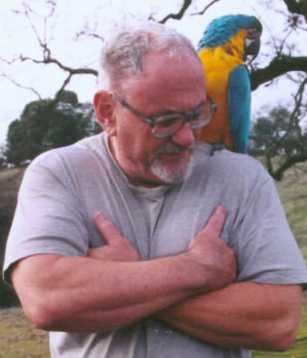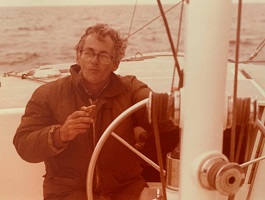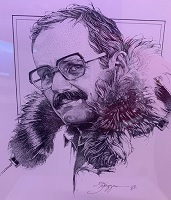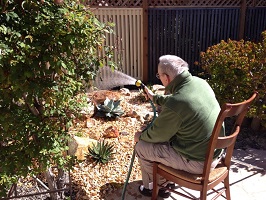

|
Home | My background | My values | My thoughts | My rates | Testimonials | Contact me | Ernie |


My mentor, colleague, Datamology co-founder, and dear friend, Ernie Anderson, passed away on June 12, 2020. This is my effort to honor and remember a man whom you likely never heard of, which is unfortunate. I have never known anyone else like him and never will.
Ernie was a high school dropout (isn't that always the case with a genius?) who built a boat by himself (self-taught, as was his wont) which he later sold to a friend who sailed it to New Zealand. Later, he used a perfect score on the SAT to gain admittance to MIT and graduated in 3 years with a degree in Mathematics. Once he learned how to program (see below), he used his knowledge of mathematics and spline theory to write a program by which one can design the hulls of ships. This gained the attention of the US Navy and earned him a meeting with Rear Admiral "Amazing Grace" Hopper (developer of the first compiler and inventor of the term "debug".) Though his program produced design specs in minutes (using advanced mathematics), whereas the Navy's program produced specs in days (using trial-and-error), he believes nothing came of that meeting because the Navy did not believe that he could have written the program, himself.
As a young man, while working out at Muscle Beach in Venice, CA, he played chess against a young boy named Bobby Fischer. He lost, much to his dismay at the time. In his later years, Ernie would become a repeat world champion powerlifter, setting bench press world records as he aged through different master divisions. At age 76, he was still benching 335 pounds. He retired from competition a couple years later. In his 80s, he was still playing chess at an expert level. The development of online chess forums had been a godsend for him due to his reclusive nature!
As for computing, during his Muscle Beach days, he saw an advertisement from International Business Machines offering to teach "the public" how to program computers. He was intrigued enough to attend the class where they used a "computer" in which one manually set each bit with physical toggles to encode each individual instruction. This was in the early 1960s and he was hooked. Though he was a polymath and would pursue many interests in his life, the one constant was programming. But he never went through any further training (that I know of). All was self-taught and, in fact, his knowledge of computers was shockingly limited. It was programming that intrigued him, not the technology around it. He thought a programming language would be sufficient with very few instructions and a competant programmer. "That's all I need." Mostly he sought ways to apply his mathematical knowledge to problems that interested him and always used the simplest of instructions to develop and use complex algorithms that he invented. Along the way, he worked on programs such as:
I met Ernie when I was hired on at Platinum technology to "work with Ernie" on PRF, a product he had invented that caught the eye of Andrew Filipowski (Flip) who had recently founded Platinum. Ernie chafed at working in the corporate environment and soon "retired" back to his computer at home. PRF went on to earn approximately $100,000,000 in revenue for Platinum (and later Computer Associates). Ernie never got rich from that success because, as he was the first to admit, "I'm a terrible business person!" But he did collect sufficient royalties to live comfortably for the rest of his life. Flip, like myself, remained a lifelong friend of Ernie's. Ernie and I would, 15 years later, found Datamology to bring another of Ernie's software inventions to life, the product that would be published as VisiCube. But, once again, Ernie chose to shed the shackles of business to return to his personal studio where he could pursue his passion projects on his own terms.
Soon after meeting Ernie, he invited my family to dinner at his home which was (naturally) unlike any other. On the outside, it was a standard mid-century Chicago suburban ranch home in an unassuming subdivision. The inside was a different story. The entire left side of the home had been reconfigured into an aviary for macaws with a glass wall separating you from the birds. Ernie regularly took the birds outside where they would happily fly about the neighborhood or, more often, sit on his shoulder. In the ensuing years, Ernie built an outdoor aviary in the back yard and connected it directly to the house so that the birds could come in and out as they wished. Finally, Ernie moved to a large property in Redwood Valley, CA, where he built a gigantic outdoor aviary in which the macaws (Bozo, Bella, Pumpkin, and others) lived for years and, finally, procreated.
To give you a better feel of who he was, I include here one of my favorite stories of his ... in his own words ... which he shared with me in 2004. Bare in mind that one of his passions was entomolgy. He collected beetles from around the world for years ... until, one day, he could no longer reconcile the fact that the beetle was killed when it was collected.
"At the end of June, 1978, I went to Guyana to collect beetles. I was interested in cerambycids then, which are large and showy in the tropics, and Guyana was like the Amazon except that English was spoken. It was then a communist country (since its independence from Britain in 1968) and, as I went through customs, I was called "Comrade Anderson". I spent a week in Georgetown, waiting for a permit to go to the Rupununi Savannah. When I got the permit, the rains had been so heavy that the destination airstrip was under water, so I was forced to go elsewhere. About the only place I could fly to without waiting for another permit, and where there was some jungle, was Mathews Ridge near the North coast, so I went there. I stayed for several days at a place called Jethro's Guest House, and here I met two people from San Francisco, a black guy and a white guy. The white guy was named Mike Prokes. They told me they were from The Peoples Temple, about 30 miles away, and invited me to visit there. They didn't mention Jim Jones. They said it was an agricultural commune of mostly Americans, many from the Bay Area. I declined because I was anxious to get into the jungle (via a Land Rover provided by Jethro's). The collecting wasn't great in this area, and a week later I was back in Chicago. About 3 months later the papers came out with the story about the 930 people who died at People's Temple. Newsweek came out with coverage of the event and on its cover was a picture of a man in handcuffs being escorted out of a plane. He had been accused of shooting the senator. It was my friend, Mike Prokes. Subsequently it turned out that he didn't do this and he was released. He had given me his phone number, but I had lost it; in any event I doubt if I would have tried to contact him - it really wasn't my business. So about 15 years later I end up living next door to former People's Temple property (literally 500 feet away)."
"Now I am returning to Guyana again (26 years after my last visit), this time to (hopefully) reach the Rupunini Savannah. I am going back - just for 2 weeks at first - to collect bugs there. After that earlier visit, I became interested in tenebrionids, which are primarily found in deserts, and I never thought of going to Guyana again. A few weeks ago I became interested in weevils and have suddenly realized that Guyana (contiguous with the Amazon Basin) is a paradise for them. The diversity of weevils is greater than that of any other kind of beetle and is correlated with the diversity of plants (weevils are exclusiovely plant feeders). Although they are generally small to minute, their variety of forms and colors is extraordinary - beyond that of any other insects. I plan to spend the two weeks at Rock View Lodge, 300 miles south of Georgetown in the remote Rupununi Savannah. This is an eco-tourism lodge that is actually part of a huge cattle ranch. There are no fences - the cattle wander freely over natural grassland that is flooded during the rainy season. The cowboys who round them up are Amerindians who ride their horses barefoot (no boots) and wear texas-style cowboy hats. The number of cattle for the size of the savannahs (20,000 square miles) is very small and there is no overgrazing. The grassland is entirely natural - nothing like the horrible devestation caused by cattle in the United States. The market for these cattle is Brazil - Georgetown gets its beef from the U.S. thousands of miles away (also its wheat). That's how poor the land communication is between the Rupunini and Georgetown."
"I got back about 6 days ago. I guess the bottom line for my trip is that the beetles I collected are at the University of Georgetown. I was not allowed to take them out of the country. I don't know what they will do with them there, as there is no entomology department and no entomologists on the faculty. I would only be allowed to collect if I was part of "a team" on a "scientific research project" connected with a university. In such a case, all the specimens would have to be identified and then returned to Guyana, less a few duplicates that my university would be allowed to keep. This procedure is dictated by Guyana's Environmental Protection Agency, modeled on the EPA for the U.S. (which is equally ignorant about insects). The entire southern half of Guyana (some 40,000 square miles) is in prestine condition because of the very low population there. This is only temporary I fear, because the population is now growing exponentially. Meanwhile, the Guyana government is granting timber rights for enormous tracts to international conglomerates - the timber wealth of Guyana is very great. This area will never be adequately collected (if at all) and in a century it will all be gone. I was completely wet for 24 hours a day the whole time I was there, and bitten thousands of times by mosquitos. The humidity was unbelievable. It turns out that I was there at the worst time for collecting - the middle of the rainy season. The food at the lodge was horrible - and I lost an additional 8 pounds during the two weeks. I really liked the Amerindians and made good friends with a fellow named Michael, who is 56 years old (his mother is 87). Michael can work very hard in the heat and humidy without the slightest effort. Jungle which is totally impossible for me to enter he just walks into and dissapears. He works two weeks for Colin Edwards (the Englishman who owns and runs Rockview Lodge) and then has 2 weeks off to work on his farm in a remote location 20 miles away, reachable only by river. Michael has 9 children, the eldest having numerous children of their own. Since the Macushi people (Michael's tribe) have been living in the Rupununi area for at least 4,000 years with a stable population, the onset of medical care, supplies and employment is resulting in a population explosion. The population here is still very low (50,000 Amerindians in all of Guyana) so the danger is not yet visible. But in a century, given the current reproductive rate, there will be 50 million Amerindians here. The Amerindians are all Christians and go to services on Sundays. "God bless you" he told me when I gave him my big maglight flashlight and a bunch of extra batteries. I was not supposed to give him any money, but they didn't say anything about gifts to a friend. I am now sending him a TI electronic calculor for his 14 year old daughter who is studying mathematics at the Amerindian school in Annai (the village near Rokview)."


Barbara, Ernie's wife, shared that his final avocation was horticulture, specifically related to aloes (a species of flowering succulents):
"Aloes was his latest passion. When we bought the house in Carmel, he turned the whole landscape into a succulents grove. He kept ordering plants from all over the world - some made it, some not. Today I enjoy the most original landscaping that perfectly fits our climate. Ernie is with me every day."
Ernie was the gentlest of souls. He was completely unassuming, kind beyond words, and funny in a self-deprecating way. He always knew that he was different, uncomfortable in public, and was totally at peace with that.
I will miss him for the rest of my days.